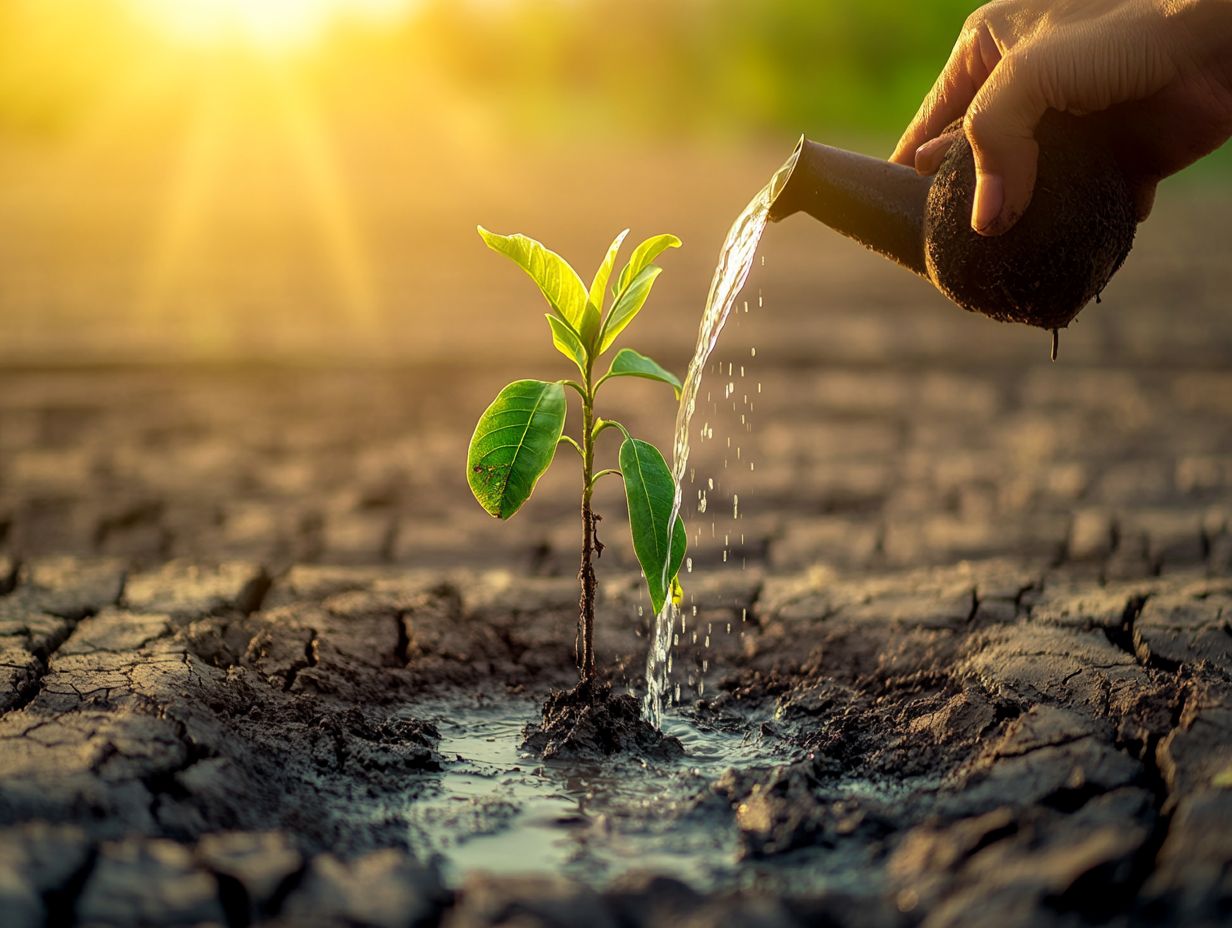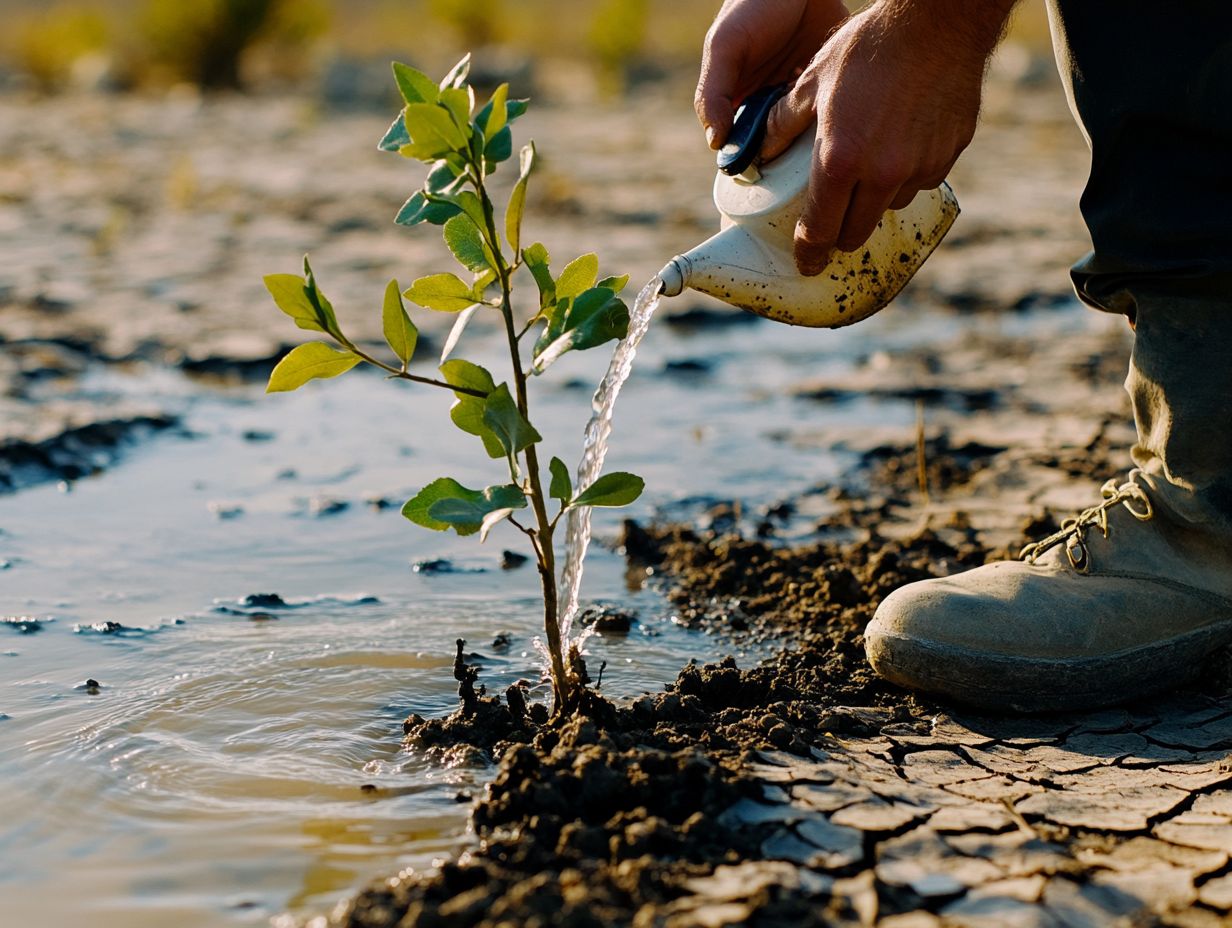Best Practices for Watering Drought Plants
Drought presents considerable challenges for gardeners and plant enthusiasts. However, mastering the cultivation of drought-tolerant plants can truly transform your gardening experience.
This article delves into the characteristics that enable plants to thrive in dry conditions. It also helps you identify the signs of drought stress.
You ll uncover effective watering techniques specifically designed for these resilient plants. Additionally, you will discover tools that enhance your watering efficiency and learn valuable conservation strategies to save water while ensuring your garden flourishes.
Let’s dive into the exciting secrets of nurturing drought-tolerant plants successfully!
Contents
- Key Takeaways:
- Understanding Drought Plants
- Signs of Drought Stress
- Master Watering for Thriving Plants
- Essential Tools for Effective and Efficient Watering
- Conservation Techniques
- Frequently Asked Questions
- What are the best practices for watering drought plants?
- How often should I water drought plants?
- Why is it important to use a drip irrigation system for drought plants?
- What is the best time of day to water drought plants?
- How can mulching help with watering drought plants?
- What should I do if my drought plant shows signs of overwatering?
Key Takeaways:

- Regularly check for signs of drought stress in plants and adjust watering accordingly.
- Consider factors such as soil type, weather, and plant species when determining watering frequency and amount.
- Utilize recommended tools and conservation techniques to efficiently water drought-tolerant plants and conserve water.
Understanding Drought Plants
Understanding drought-tolerant plants is crucial for cultivating a flourishing garden. This is especially true in areas like California that face frequent water shortages.
These resilient plants help conserve water and excel in tough conditions. They adapt their growth patterns to thrive with minimal irrigation.
Experts like Jessica Damiano from the California Department of Water Resources emphasize that choosing water-efficient plants and implementing conservation strategies, including essential pruning techniques for drought plants, can result in thriving gardens. These gardens not only endure drought but also bolster the surrounding ecosystem.
What Makes a Plant Drought-Tolerant?
Drought-tolerant plants showcase remarkable adaptations that enable them to flourish in arid conditions. This makes them essential for water-efficient gardening.
You ll find that these plants often boast deep root systems, waxy leaves, or specialized tissues designed to minimize water loss while maximizing moisture absorption from the soil.
Certain species have even evolved to store water in their tissues. This allows them to weather extended dry spells with grace. For instance, native succulents like agave and various cacti stand out as superb choices for sustainable gardens, adeptly managing water resources.
Their resilience enhances the visual appeal of your landscape and supports local ecosystems. They provide vital habitats for pollinators and wildlife.
By integrating drought-tolerant varieties into your landscaping, you can craft vibrant, low-maintenance environments. These environments significantly reduce water consumption while nurturing biodiversity.
Signs of Drought Stress
Recognizing the signs of drought stress in your plants is essential for timely intervention and effective gardening. This is particularly important in areas facing severe drought conditions.
Symptoms like wilting, discoloration, and leaf drop signal that a plant is struggling to manage insufficient moisture levels. By identifying these symptoms early, you can adopt strategies to conserve water and enhance your plants’ health. This ensures they thrive even in challenging conditions.
Identifying Symptoms in Plants

Identifying the symptoms of drought in your plants is crucial for maintaining a flourishing garden, especially in regions facing water restrictions. Look out for common indicators such as wilting leaves, yellowing foliage, and premature leaf drop. These signs indicate your plants are thirsting for hydration.
Beyond these visible cues, you might notice stunted growth and browning leaf edges. These suggest that your plant is focusing more on survival than on thriving. To gauge the overall health of your plants, check the soil moisture by inserting your finger about an inch deep. If it feels dry, it s time to rethink your watering strategy.
Establish a consistent watering schedule. Apply mulch to help retain moisture and choose plants that need less water. Implementing water-saving gardening techniques for drought can significantly bolster your plants’ resilience during dry spells. Act now to keep your garden bursting with life!
Master Watering for Thriving Plants
Proper watering techniques are essential for nurturing plant health and optimizing water efficiency, especially in gardens facing water scarcity. Utilizing the top tools for caring for drought plants can enhance strategies like deep watering, ensuring that moisture penetrates the root zone and fosters robust growth and resilience against drought conditions.
Using tools like soaker hoses and drip watering systems can elevate your garden care. These tools deliver water directly to the soil while minimizing evaporation and waste.
Key Factors for Effective Watering
When determining the best watering practices for your garden, consider several key factors to optimize moisture retention and promote plant health. Elements such as soil type, plant species, and local climate conditions significantly influence how often and how much water you should apply.
Soil composition greatly impacts how quickly moisture drains and retains nutrients. For instance, sandy soil drains rapidly, requiring more frequent watering, while clay soil holds water longer but may become compacted.
Different plants also have unique water needs. Succulents typically tolerate dryness better than tropical species. Local weather patterns, including humidity and temperature fluctuations, further influence evaporation rates.
By closely monitoring these factors and adjusting your watering schedule accordingly perhaps by using drip irrigation (tools that deliver water slowly to the roots) you can ensure your plants thrive while avoiding the pitfalls of over or under-watering.
Best Practices for Watering Drought-Tolerant Plants
Employing best practices for when to water drought-resistant plants is essential for effective gardening and water conservation. Consider these techniques:
- Apply mulch to retain moisture.
- Use rain barrels to capture water.
- Schedule watering during the cooler parts of the day.
These methods help maintain the health of your plants and foster a sustainable garden environment. For instance, applying mulch retains soil moisture and curtails weed growth, reducing the need for additional watering. Integrating rain barrels allows you to capture natural rainfall, turning waste into a valuable resource.
Watering in the early morning or late evening minimizes evaporation loss. Consider using drip irrigation systems to deliver water directly to the root zone for maximum efficiency. By incorporating these best practices for drought-resistant gardening into your routine, you’ll promote drought resilience while conserving precious water resources.
With these strategies, you’ll not only keep your garden thriving but also become a champion of water conservation!
Essential Tools for Effective and Efficient Watering

Selecting the right watering tools can elevate your gardening while promoting water conservation.
Tools like soaker hoses and drip irrigation systems deliver water directly to the roots, minimizing waste and ensuring your plants get the moisture they need.
Rain barrels are a fantastic option! They capture and store rainwater for irrigation, helping you create a water-efficient garden.
Recommended Tools for Efficient Watering
Using the right tools can significantly enhance plant health and water conservation. Consider adding soaker hoses and drip irrigation systems to your routine; they provide water directly to the roots while cutting down on evaporation. Additionally, learning how to keep drought-resistant plants healthy can further improve your gardening efforts.
Rain barrels also play a vital role. They let you take advantage of natural rainfall for irrigation.
These systems not only reduce water waste but also contribute to a healthier, more sustainable garden. Soaker hoses encourage deep moisture penetration, perfect for rows of vegetables and flower beds. Drip irrigation is especially useful in areas with unpredictable rainfall, ensuring each plant receives just the right amount of water, with no runoff.
Rain barrels offer a cost-effective solution that supports eco-friendly practices and reduces your reliance on municipal water sources. Combining these tools helps foster a thriving ecosystem while conserving precious water resources.
Conservation Techniques
<pImplementing effective conservation techniques is crucial for maintaining plant health and promoting sustainability, especially in drought-prone areas.
Using mulch retains soil moisture, enriching soil health with compost. Utilizing gray water systems also significantly boosts your water conservation efforts.
Opting for native plants enhances your garden’s beauty while providing natural resilience, reducing the need for extra watering.
Strategies for Conserving Water
Employing effective strategies for conserving water is essential for sustainability and healthy plant growth. By using deep watering techniques, along with practices like mulching and planting native species, you can greatly reduce water usage while keeping your garden vibrant.
These methods not only minimize your environmental footprint but also create a low-maintenance oasis. For instance, mulching retains soil moisture, suppresses weeds, and improves soil health as it breaks down.
Choosing drought-resistant plants and arranging them based on their water needs enhances efficiency, allowing for targeted care. For more information, check out the best seasonal care for drought plants.
Using a rain barrel is a smart move! It collects rainwater for irrigation and decreases reliance on tap water. These strategies support resource conservation while nurturing an ecosystem that benefits local wildlife.
Frequently Asked Questions

Here are some common questions about watering drought-resistant plants:
What are the best practices for watering drought plants?
- Water deeply and infrequently.
- Use a drip irrigation system.
- Apply mulch to retain moisture.
- Avoid watering during the hottest part of the day.
How often should I water drought plants?
Water drought plants deeply and infrequently, typically once or twice a week, depending on the specific plant and its water needs. For more insights, check out these essential tips for planting drought-tolerant species.
Why is it important to use a drip irrigation system for drought plants?
A drip irrigation system delivers water directly to the plant’s root zone, preventing water loss through evaporation and ensuring the plant receives the right amount of water without wasting any.
What is the best time of day to water drought plants?
Water your drought plants early in the morning or in the evening. This timing is best because temperatures are cooler, reducing water evaporation. For more comprehensive advice, check out these tips for maintaining plant health in drought.
How can mulching help with watering drought plants?
Mulching keeps the soil damp and reduces weeds. It also helps control soil temperature, benefiting drought plants and cutting down on watering needs.
What should I do if my drought plant shows signs of overwatering?
If you see yellowing leaves or wilting, your plant may be overwatered. Act quickly; cut back on watering and ensure the soil dries out before the next watering.






